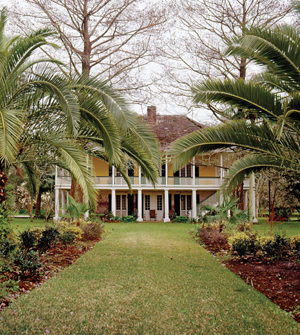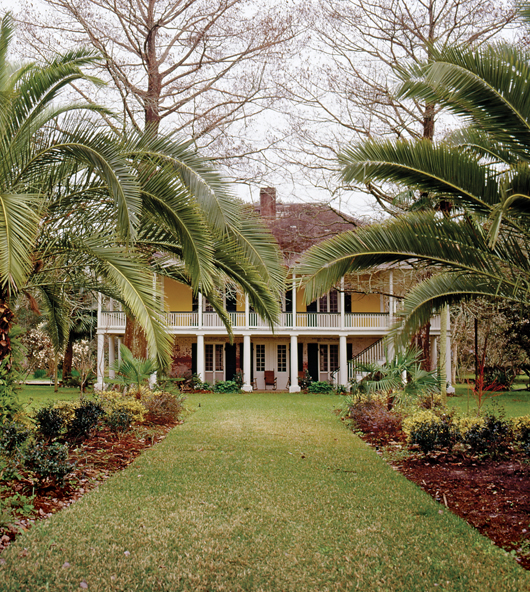
BRAITHWAITE, La. (AP) – A grand white-pillared plantation house built on historic River Road near the Mississippi nearly 200 years ago will be sold in a March 10 auction that could provide a new twist in its colorful history.
Over the centuries, the yellow home with its green shutters overlooking exotic gardens survived a British invasion, the Civil War and the ravages of hurricanes Betsy, Camille and Katrina.
The home offers a glimpse into Louisiana’s past, with original horsehair plaster walls, red brick floors and upstairs French doors that open to a wraparound gallery ushering in breezes.
Auctioneers are hopeful the romanticism of River Road and the beauty of the relic-filled home will fetch a hefty price for the property, called Mary Plantation. The plantation had been listed for traditional real estate sale by its owners, historic preservationist and noted antiquarian Blaine Murrell McBurney and his wife, Stephanie, since 2010 with listing prices in the $1 million range, albeit in a slumped real estate market.
Neal Alford, president of Neal Auction Co., said the plantation will be offered at absolute auction, which means there is no minimum or reserve price and the property will go to the highest bidder.
“It’s a compelling, rare opportunity, to acquire a historic property at a potential bargain,” said Alford, whose company specializes in antiques and exotic properties. “The property will sell regardless of price.”
Neal has sold some of Louisiana’s grandest old homes at absolute auction, including Bocage Plantation in Darrow, La., and the Spanish Custom House in New Orleans. Both of those homes sold for more than $1 million, but Mary Plantation’s more isolated location miles from the heavily-traveled stretch of River Road between New Orleans and Baton Rouge may make it harder to land that high a bid.
Bocage Plantation is among the dozens of historic homes that are now tourist attractions. It offers tours daily and serves as a bed and breakfast. Other historic River Road homes open for public tours include Houmas House, also in Darrow, Oak Alley and Laura Plantation in Vacherie, Destrehan Plantation in Destrehan and Nottoway Plantation in White Castle
So tourism might be the next stage in the life of Mary Plantation, where fields of indigo, rice and citrus once flourished at the hands of slaves forced into labor before the Civil War. Over the years much of the original site was sold and the property now has 7 acres.
Few early land records exist, but Mary Plantation was built by slaves on land owned by French planter Francois Delery in the late 1700s and expanded to its current state on tall white pillars with a raised red brick foundation around 1827. The plantation was presumably named for Delery’s wife, Marie Marthe Victoire Bienvenu.
Tour companies don’t regularly pass through Braithwaite, but the potential is there, Alford said. The drive from New Orleans to Brathwaite passes through the city’s Lower 9th Ward, the area where actor Brad Pitt’s Make It Right rebuilding effort is taking place, and the battlefield where Andrew Jackson defeated an invading British army in 1815.
River Road is dotted with citrus orchards and oak trees, and other historic buildings are to the south along the Mississippi.
“People who are looking for historic properties are interested in that romanticism that comes with owning an old home and sharing it with others,” Alford said. “Certainly, the possibility for a crossover into tourism is there.”
Foster Creppel, owner of Woodland Plantation in West Pointe a la Hache, said most of his business comes from tours and fishing charter services needing accommodations. He thinks Mary Plantation has potential.
“It could be a very nice business,” Creppel said. “It just may take some time.”
Creppel said it has taken years to build his business, which includes the 1834 Woodland Plantation home on roughly 50 acres, an old church he uses for special events and a restaurant that serves Louisiana cuisine.
Susanne Romig, marketing director for Nottoway Plantation, said a big obstacle to the plantation tour business has been Mother Nature. But high gas prices and the bad economy have hurt, too, she said.
Hurricane Gustav in 2008 ripped off a section of Nottoway’s roof and collapsed several chimneys. While closed for repairs, the owners expanded the property by adding a carriage house, ballroom and nine Acadian-style cottages modeled after the property’s original slave quarters.
“Hospitality anywhere in the world is tough, but here in Louisiana there are so many factors,” Romig said. “Weather is one of the biggest things that can affect business.”
For months after Hurricane Katrina in 2005, local tourism was all but dead.
Norman Marmillion, owner of Laura Plantation, which offers tours in French and English, said 95 percent of his business comes from New Orleans. After Katrina—with New Orleans abandoned for a time—he had no business and was forced to let most employees go.
Marmillion said business is back to about 85 percent of pre-Katrina levels. He’s looking forward to the return of steamboat cruises along the Mississippi River in April after a four-year hiatus. “That’s been the missing link in our business,” Marmillion said. Two riverboats are expected to resume service in April, and two more in 2013, Marmillion said.
Mary Plantation may lend itself nicely to tours, Creppel said. The home, added to the National Register of Historic Places in 1983, is one of the oldest surviving structures in Plaquemines Parish. It has a formal dining room and bath downstairs and three bedrooms with two bathrooms upstairs. Some of its hardware dates from the 18th century.
A stable has been converted into an air-conditioned guest house and captures the character of the main house with red brick floors, cypress wall paneling and a fan-shaped stained glass window above French doors.
Behind the house is a building likely used as a dairy and livestock shed. It resembles a raised log cabin and reflects early Louisiana construction methods.
The plantation’s contents, including some of the earliest-known fine Louisiana furnishings, will be sold immediately after the March 10 property auction. Included is furniture from the collection of McBurney, who purchased the home in 2003. The McBurneys have holdings across the nation and are selling Mary Plantation to devote more attention to interests in Europe, Alford said.
The original home was expanded in 1827. But it fell into neglect over the years until the 1940s when biologist Elmer “Eric” Knobloch and his wife, Marguerite, bought it and added modern amenities and rare tropical greenery to the gardens.
For decades, the Knoblochs hosted tours, picnics and parties at Mary, and it became a magnet for preservationists and naturalists. The house suffered only minor damage during Katrina in 2005 and was quickly repaired.
Alford thinks the plantation’s charm will draw interest, whether as a primary residence or tourism venue.
“An auction is the way to go with a property like this,” Alford said. “It’s unique. It’s one moment, and you have to act in that moment or you lose it.”
___
Online:
Neal Auction: http://www.nealauction.com/indexnet.html
Copyright 2012 Associated Press. All rights reserved. This material may not be published, broadcast, rewritten, or redistributed.
AP-WF-03-02-12 2050GMT
ADDITIONAL IMAGE OF NOTE



